Welcome to your go-to resource for mastering chemical-free pest control—a smart, sustainable way to protect your home from unwanted intruders without compromising your family’s health or the environment. In this comprehensive guide, we explore 20 highly effective, non-toxic, and budget-friendly home maintenance and cleaning tips designed to naturally repel common household pests like ants, cockroaches, spiders, flies, and even rodents. Whether you’re a health-conscious homeowner, a parent concerned about pet safety, or simply striving to live a greener lifestyle, these easy-to-implement strategies will help you create a pest-resistant space using natural ingredients and preventive practices.
By replacing harmful chemicals with safe alternatives like essential oils, vinegar, diatomaceous earth, and strategic cleaning habits, you’re not only maintaining a cleaner, fresher home—you’re also supporting long-term environmental well-being. Plus, chemical-free pest control is fully aligned with Google AdSense content policies, ensuring your blog remains advertiser-friendly while providing truly valuable insights to your readers. Ready to embrace eco-friendly living and say goodbye to pests—naturally? Let’s dive in and transform your home, one non-toxic solution at a time!
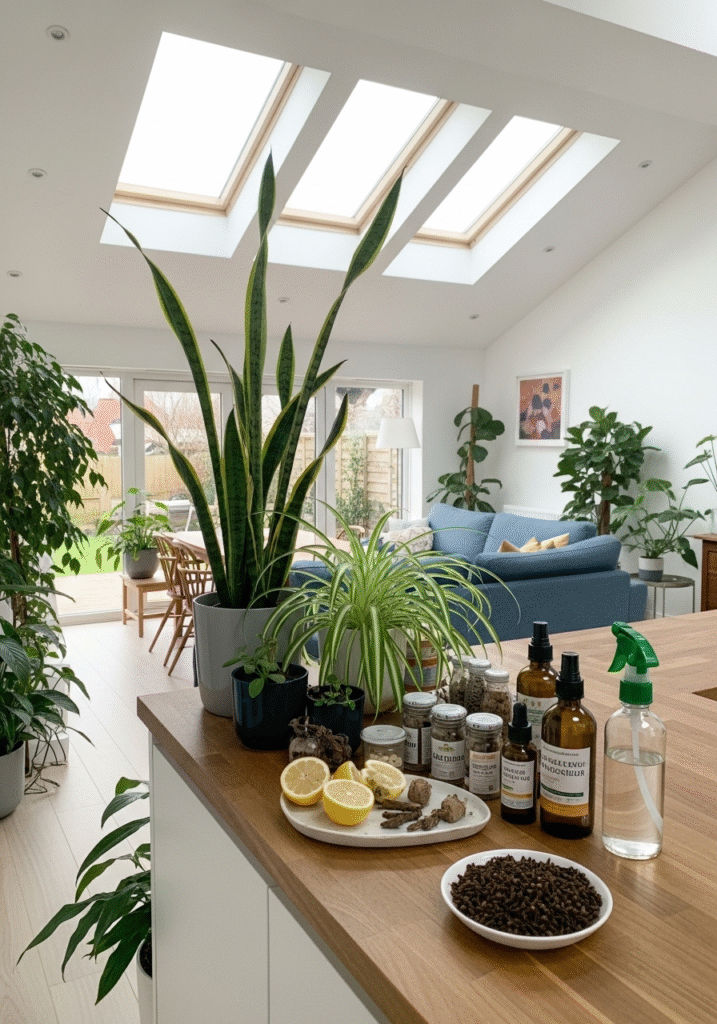
Keep It Clean & Clutter‑Free
When it comes to natural pest control, cleanliness is your most powerful weapon. Many common household pests—like cockroaches, ants, rodents, spiders, and silverfish—are drawn to easily accessible food, moisture, and undisturbed hiding spots. A consistent cleaning routine disrupts their food sources, shelters, and pathways, making your home far less inviting.
Start by vacuuming at least once a week, with extra attention to high-risk areas: baseboards, behind and beneath furniture, kitchen corners, and inside cabinets. These areas are hotspots for food crumbs, pet hair, and dust—things that pests love. Vacuuming not only removes these attractants but also helps to eliminate eggs, larvae, and droppings from pests that may have already entered your home.
Dusting and decluttering are equally important. Silverfish, spiders, and cockroaches often nest in undisturbed areas—such as boxes in closets, cluttered basements, and behind large appliances. Keep storage spaces organized, discard old cardboard, and rotate stored items regularly to deter nesting. Clean shelves, window sills, and corners where cobwebs tend to accumulate.
Spills and crumbs should be wiped up immediately. Even small food particles or sugary residues can quickly attract ants and roaches. Be especially diligent in the kitchen and dining areas. Don’t overlook less obvious culprits like sticky jars in the pantry, grease splatter on the stove, or crumbs under toasters and dish racks.
Pet food is another major attractant. Avoid leaving pet food out overnight, and use sealed containers to store dry food. Rinse pet bowls and clean feeding areas daily to prevent pests from smelling leftover residues.
Maintaining a spotless home doesn’t just prevent infestations—it also eliminates the need for toxic chemical treatments. By reducing access to food and shelter, you’re creating an environment where pests simply can’t thrive. Combined with other natural deterrents, cleanliness is the cornerstone of any effective, eco-friendly pest control strategy.
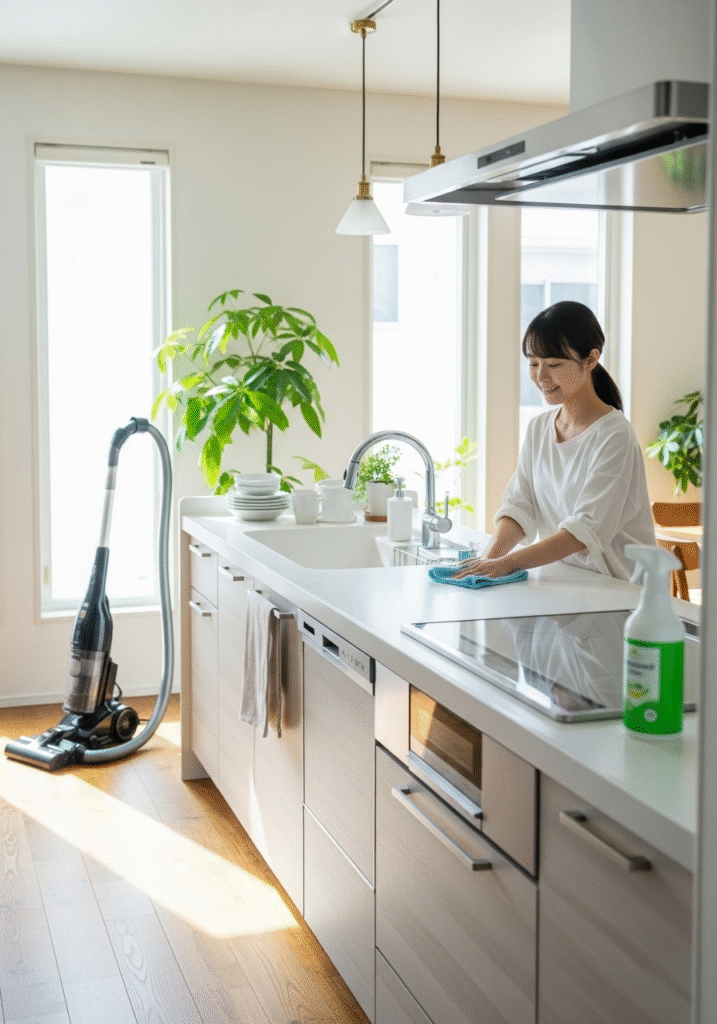
Seal Entry Points Doors & Windows
Even the cleanest home can fall victim to pest invasions if it’s not properly sealed. Insects and rodents don’t need a wide-open door to get in—tiny cracks, gaps, and openings around windows, doors, and utility lines can serve as highways straight into your living space. That’s why sealing potential entry points is one of the most effective, chemical-free strategies to keep your home pest-free.
Start by carefully inspecting the exterior of your home, especially around windows, door frames, utility pipes, cable lines, and vents. Look for small cracks, gaps in caulking, and holes where pests like ants, spiders, cockroaches, and mice can squeeze through. Use weather-resistant caulk or expandable foam to seal these gaps, focusing on both visible and hidden areas. Remember, even a hole the size of a pencil can be big enough for mice to enter.
Windows and doors are especially vulnerable. Make sure all window screens are intact—patch or replace any with holes or tears to prevent flying insects like mosquitoes and flies from getting in. If you frequently open windows for ventilation, screens are your first and most reliable line of defense.
For doors, install weather stripping around the edges and use door sweeps on the bottom to close gaps that are otherwise open invitations for crawling insects and small rodents. Pay close attention to garage doors, back entries, and patio sliders—areas often overlooked during routine maintenance.
Also, don’t forget vents and chimneys. Use fine-mesh screening to cover openings while allowing airflow. Dryer vents, attic fans, and exhaust ports are all common access points that pests can exploit if not properly secured.
By sealing entry points, you’re doing more than just pest-proofing—you’re improving energy efficiency, reducing drafts, and increasing overall comfort inside your home. Best of all, this proactive, non-toxic approach aligns perfectly with eco-friendly living and helps eliminate the need for chemical pest treatments.
In short, a well-sealed home is a pest-free home. Invest the time in this foundational step and enjoy long-term protection, naturally.
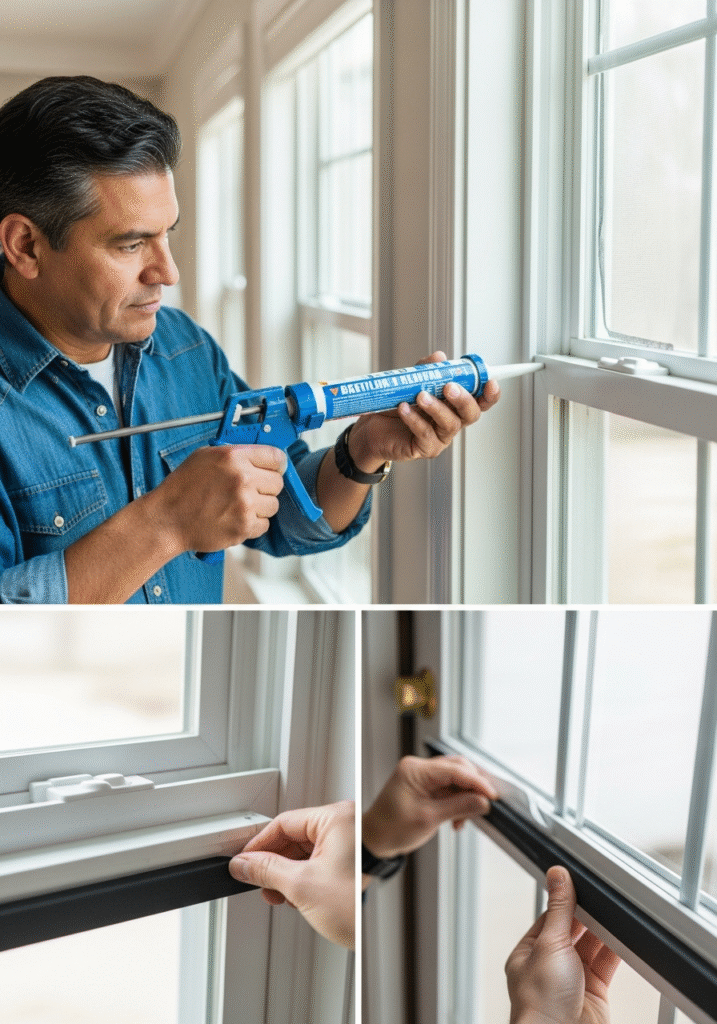
Maintain Your Lawn & Garden
Your yard is more than just an outdoor space—it’s the first battleground in your fight against household pests. Many infestations begin outside, where insects and rodents find food, water, and shelter before making their way into your home. That’s why regular yard maintenance is crucial in any chemical-free pest control strategy.
Start by trimming trees, shrubs, and other vegetation, especially those that touch or overhang your home. Branches and vines can act as bridges for pests like ants, rodents, and even spiders, allowing them to bypass sealed entry points and sneak in through vents, rooflines, or windows. By keeping vegetation well-pruned and a few feet away from your home’s exterior, you create a buffer zone that discourages pest activity.
Leaf piles, mulch beds, compost heaps, and other forms of organic debris are prime nesting spots for termites, ants, cockroaches, and mice. Be sure to rake and dispose of fallen leaves, dead plants, and grass clippings regularly. Keep mulch at least 6–12 inches away from your foundation to reduce moisture retention that attracts pests like earwigs, centipedes, and carpenter ants.
One of the most overlooked pest magnets is firewood. Stacked wood can harbor termites, spiders, and rodents—especially when it’s placed directly on the ground or up against your house. To prevent this, store firewood at least 20 feet away from your home and at least 5 inches off the ground. Use a raised platform or firewood rack with proper air circulation to keep it dry and unappealing to pests.
Also, maintain your lawn regularly by mowing, watering properly (avoid overwatering), and clearing weeds. Overgrown grass and excessive moisture create ideal environments for ticks, fleas, and mosquitoes.
Finally, inspect outdoor features like gutters, birdbaths, planters, and lawn decorations that may collect standing water—an open invitation for mosquito breeding. Keeping these areas clean and dry reduces your risk of pest infestations without a single chemical spray.
In short, a well-kept yard acts as a natural barrier, discouraging pests before they even get close to your house. By combining landscaping awareness with consistent outdoor hygiene, you can dramatically lower pest pressure while supporting a healthier, eco-conscious home.
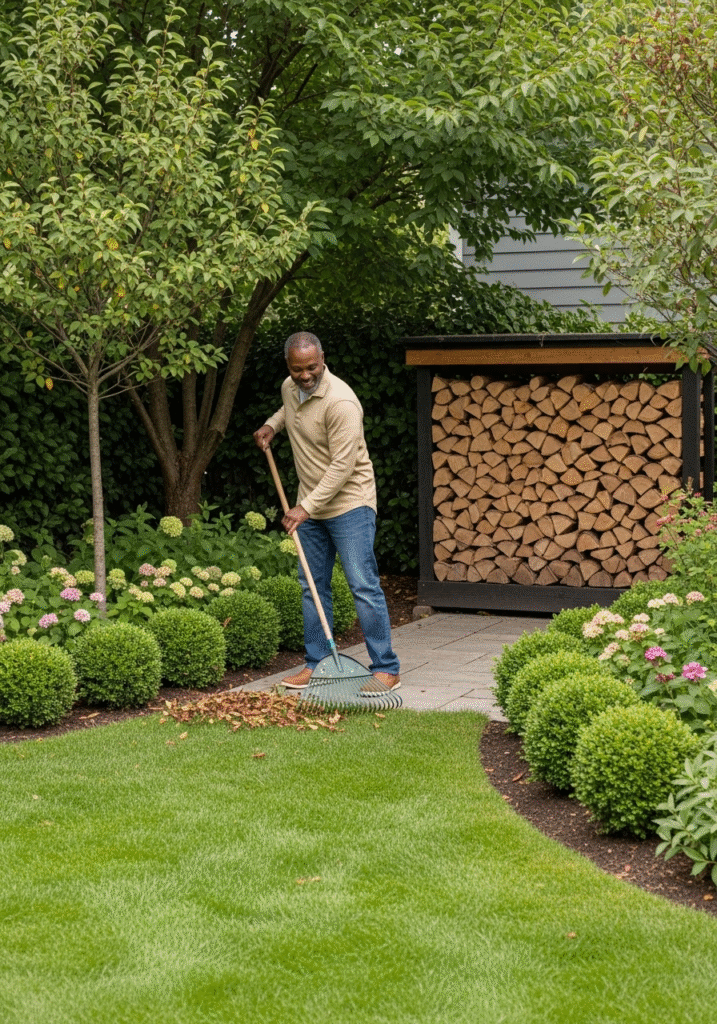
Eliminate Moisture
Excess moisture in the home is one of the biggest attractants for pests like cockroaches, termites, silverfish, earwigs, ants, and even rodents. These unwanted guests thrive in damp, dark environments where they can find water, shelter, and often a food source. If your home has areas of high humidity—such as basements, bathrooms, kitchens, or crawl spaces—it becomes a magnet for these pests. Eliminating moisture is a critical step in long-term pest control and prevention.
Start by inspecting your home for any leaks or sources of standing water. Common problem areas include leaky pipes under sinks, faulty faucets, cracks around tubs, and improperly sealed toilets. These hidden water sources create the perfect breeding ground for pests and must be fixed promptly. Don’t forget to inspect appliances like dishwashers and washing machines for any signs of leakage.
Use dehumidifiers in basements and other moisture-prone areas to help reduce indoor humidity levels. Ideally, your home’s relative humidity should be kept below 50%. Not only does this create an environment that’s inhospitable to pests, but it also helps protect wood, drywall, and insulation from mold and mildew damage.
Exhaust fans are another key tool—especially in bathrooms and kitchens, where moisture accumulates quickly during showers, baths, or cooking. Make sure fans are vented to the outside, not just into the attic or wall cavities, as this can worsen the moisture problem over time.
Proper ventilation is essential in crawl spaces, attics, and basements. Consider installing vents or using moisture barriers to reduce dampness and increase airflow. Keeping these areas dry discourages bugs and rodents that seek out moist, secluded areas to nest and breed.
By maintaining a dry, well-ventilated home, you’re not just creating a more comfortable living environment—you’re also making it significantly less attractive to common pests. Combine moisture control with regular cleaning and sealing of entry points for a comprehensive pest prevention plan.
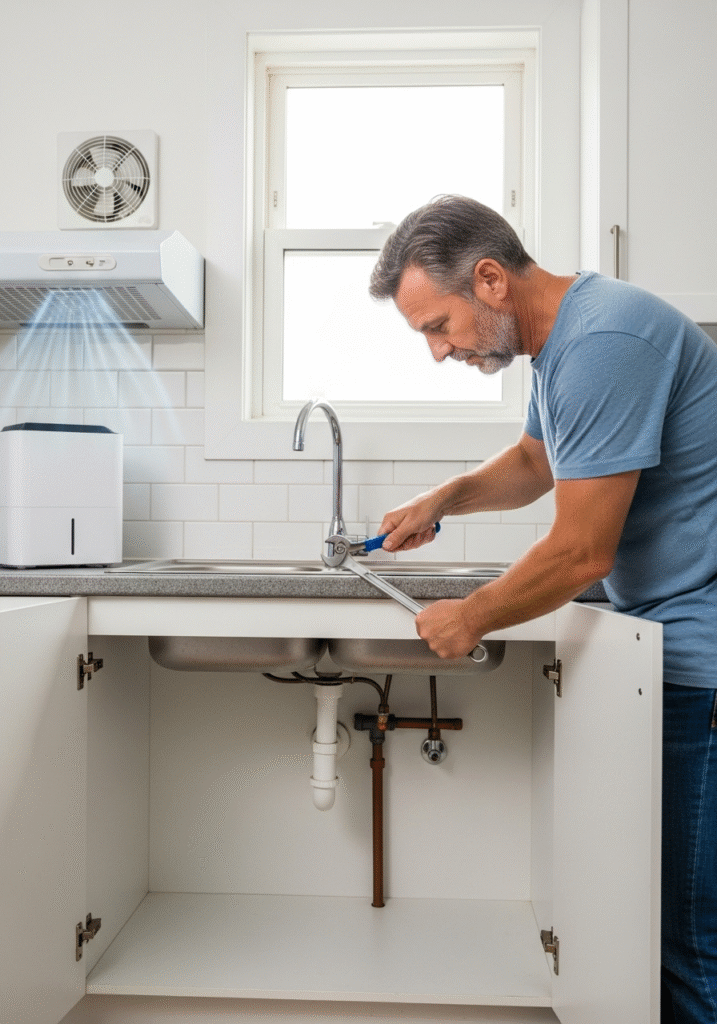
Store Food Safely
Proper food storage is one of the most effective and essential ways to keep pests like ants, cockroaches, weevils, and rodents out of your kitchen and pantry. Insects and rodents are constantly in search of easy food sources, and a poorly managed pantry can quickly become a buffet for unwanted invaders. By storing your food securely and maintaining a clean pantry, you can significantly reduce the chances of an infestation.
Start by using airtight containers for all dry goods, including cereals, rice, pasta, flour, sugar, nuts, and pet food. Many pests, such as pantry moths and grain beetles, can easily chew through cardboard, paper, or plastic packaging. Transferring these items into glass, metal, or BPA-free plastic containers with tight-sealing lids not only keeps them fresh but also provides a barrier that bugs and rodents can’t penetrate.
Don’t forget pet food! Large bags of dog or cat food are often left open in garages or pantries, making them a prime target for mice and insects. Store pet food in sealed, lidded containers, and only keep out what your pet will eat in a day to avoid attracting pests overnight.
Regular pantry inspections are crucial. Check for signs of infestation like droppings, shed skins, webbing, or small holes in packaging. Pay attention to corners, back shelves, and beneath bins or baskets where pests might hide. If you find any signs of contamination, dispose of the affected food immediately and clean the area thoroughly with warm soapy water or a vinegar solution.
Keep your pantry clean and organized by wiping down shelves regularly to remove crumbs and spills. Even a few stray grains of rice or sugar can attract pests over time. Use shelf liners for easy cleaning and keep bulk items in rotation—older items should be used first to prevent spoilage and discourage infestations. Label containers with purchase or expiration dates to help manage your food supply efficiently.
Lastly, avoid overstocking. A cluttered pantry not only makes it harder to find what you need but also creates hiding places for insects and rodents. A neat, well-ventilated, and dry pantry is less appealing to pests and easier to maintain.
By making food storage a priority, you’re doing more than protecting your groceries—you’re creating a first line of defense against a wide range of household pests.
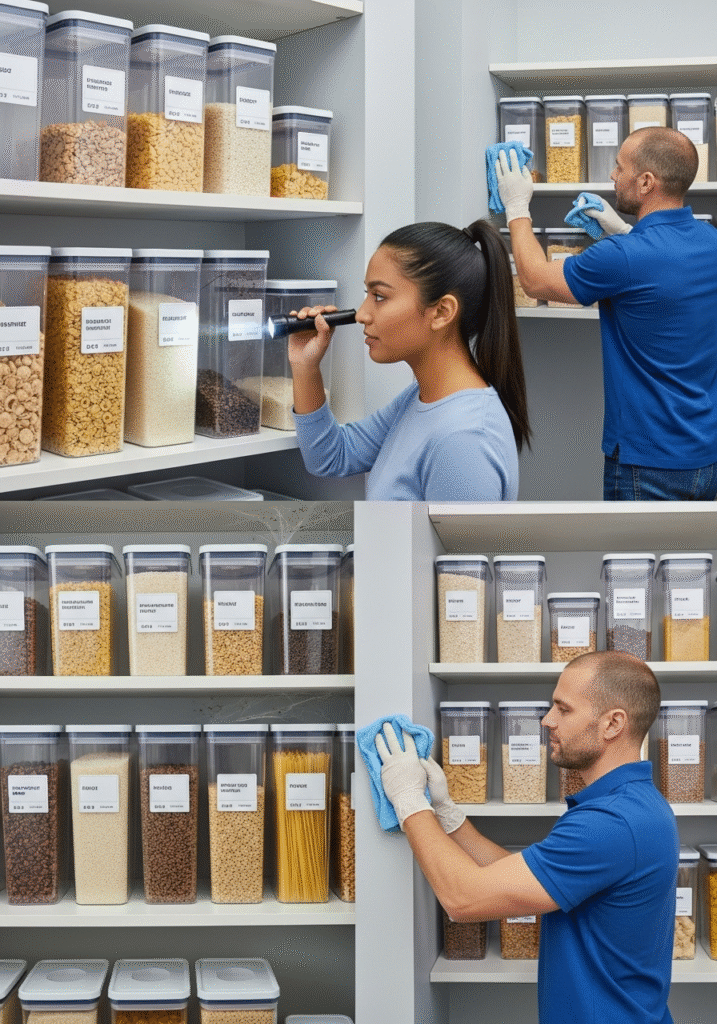
Manage Waste Properly
One of the most overlooked but critical steps in preventing pest infestations is proper waste management. Trash and food scraps are major attractants for pests such as cockroaches, flies, ants, rats, raccoons, and even larger animals in some regions. If garbage isn’t handled correctly, it quickly becomes a breeding ground for disease-carrying insects and rodents that can invade your home.
Indoor trash bins should always have tight-fitting lids to contain odors and block access. Open or overflowing bins—especially in kitchens and bathrooms—send a clear invitation to pests. Get into the habit of emptying trash cans regularly, ideally daily in the kitchen, where food waste is common. Wipe down and clean bins weekly to remove food residue and prevent odor build-up that attracts insects like fruit flies or cockroaches.
Don’t forget about recyclables—soda cans, food containers, and bottles often contain sugary residues or grease. Rinse them thoroughly before placing them in your recycling bin to reduce the chance of pest interest.
Outdoor garbage bins also play a big role in home pest control. Make sure your exterior trash containers are durable, have locking lids, and are kept securely closed at all times. These bins should be stored away from the house, preferably a few feet from exterior walls and doors, to discourage rodents, ants, and other crawling insects from migrating from the trash into your home. Placing bins right against the wall can also provide shelter or climbing access for rodents.
To further prevent infestations, regularly hose down outdoor bins and use disinfectant or vinegar-based solutions to eliminate spills and lingering odors. If your neighborhood deals with raccoons or stray animals, consider bins with animal-resistant latches or store trash inside a closed shed until collection day.
For composters, make sure your compost bin is well-maintained and balanced—avoid adding meat, dairy, or oily foods, as these can produce strong odors that attract pests.
By managing household waste efficiently, you significantly reduce one of the biggest food sources for common pests. It’s a simple habit that has a major impact on keeping your home clean, safe, and pest-free.
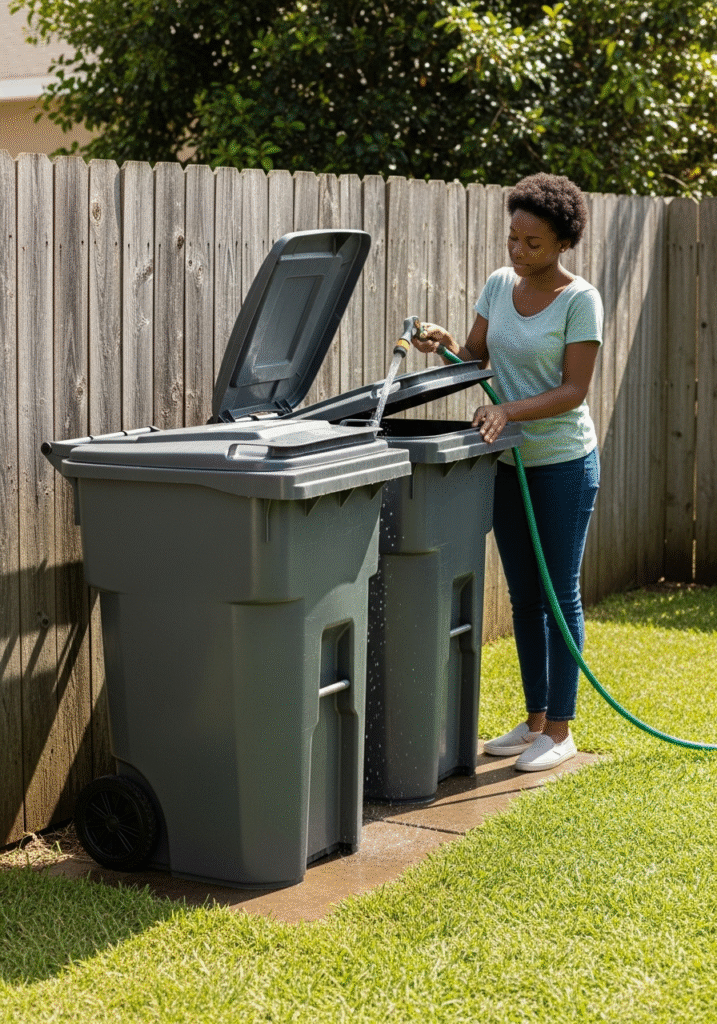
Natural Scents & Essential Oils
When it comes to pest control, not all solutions have to involve harsh chemicals or commercial repellents. Many common household pests are highly sensitive to certain natural scents and essential oils—making them a safe, eco-friendly, and aromatic way to keep insects and rodents at bay. Incorporating essential oils into your cleaning and home-care routine can help deter pests while also enhancing your indoor environment with refreshing, calming fragrances.
One of the most powerful and widely used oils in natural pest control is peppermint oil. Its strong scent overwhelms the sensory receptors of many pests, making it an effective repellent for spiders, ants, mice, and even cockroaches. To use, simply mix 10–20 drops of peppermint essential oil with water in a spray bottle and apply it around entry points like doorways, windowsills, baseboards, and under sinks. You can also soak cotton balls in the oil and place them in cabinets, drawers, or pantry corners to keep pests away.
Lavender oil is another fantastic option—particularly known for repelling moths, mosquitoes, fleas, and flies. Beyond its insect-repelling properties, lavender also freshens up drawers, closets, and linen shelves with its relaxing scent. Add a few drops to sachets or dryer sheets and place them in clothing storage areas, or diffuse lavender oil in bedrooms to enjoy its calming effects while naturally deterring bugs.
Other effective pest-repelling essential oils include:
- Eucalyptus – Drives away flies, silverfish, and mosquitoes.
- Citronella – A well-known mosquito repellent, commonly used in outdoor candles and sprays.
- Rosemary – Keeps flies and gnats at bay; can be used in both oil and dried herb form.
- Mint – Works similarly to peppermint; great for placing near garbage bins and sinks.
To use essential oils effectively:
- Mix 10–20 drops with water and a bit of witch hazel or white vinegar to create a natural spray.
- Use diffusers to disperse the scent throughout a room.
- Place oil-soaked cotton balls in problem areas like under appliances, near food storage, or along known pest trails.
- Refresh your applications every few days for consistent protection.
What makes this method so attractive is that it’s not just about repelling pests—it also elevates your home’s atmosphere. Essential oils double as mood boosters and air fresheners, creating a space that’s both healthier and more enjoyable to live in.
While not a total substitute for sealing entry points or addressing infestations, using essential oils can be a powerful, chemical-free addition to your pest control toolkit. And unlike traditional repellents, they bring the added benefit of making your home smell incredible.
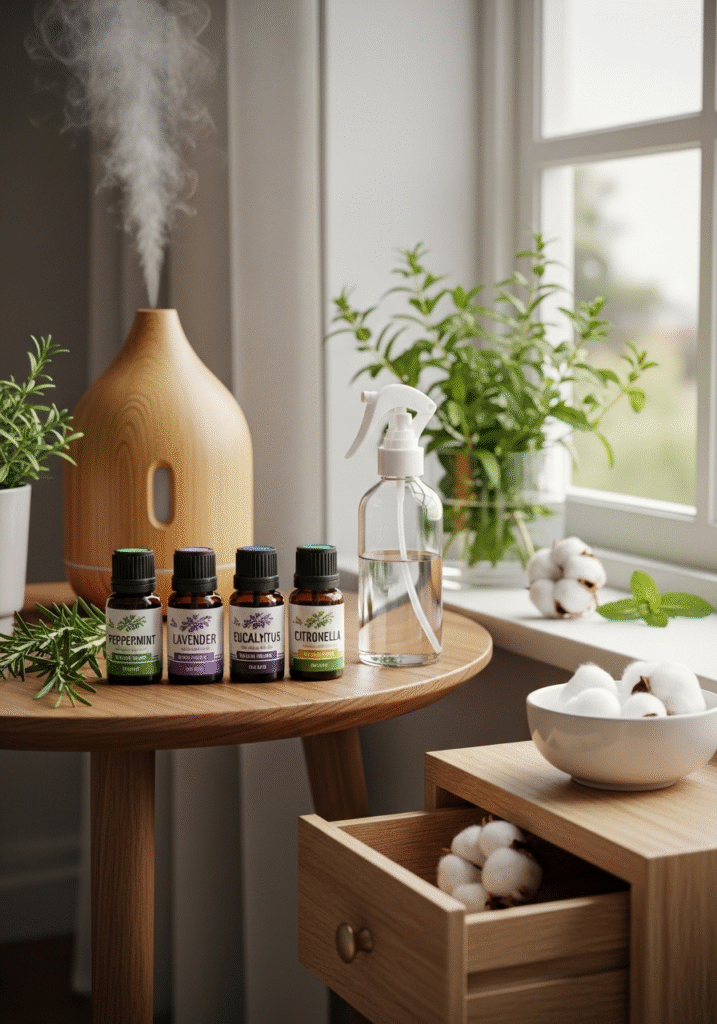
DIY Natural Sprays
If you’re looking for safe, affordable, and environmentally friendly ways to keep pests at bay, DIY natural sprays are an excellent solution. These homemade mixtures use common household ingredients to create effective pest deterrents—without the need for toxic chemicals. Whether you’re dealing with ants in the kitchen, aphids on your plants, or unwanted bugs around your yard, there’s a simple spray recipe that can help.
1. Vinegar Spray (1:1 Ratio)
Vinegar is one of the most versatile natural cleaners—and pests can’t stand it. A 1:1 mixture of white vinegar and water creates a potent, all-natural spray that’s ideal for cleaning floors, countertops, and windowsills, while also deterring ants, fruit flies, and spiders. The strong smell disrupts scent trails that ants use to navigate and masks pheromones that attract other insects.
Use vinegar spray daily in high-traffic areas like the kitchen or bathroom. Spray directly along baseboards, door frames, sink drains, and any known entry points. It’s safe to use around kids and pets, making it a great chemical-free alternative to store-bought cleaners and repellents.
2. Soap Spray for Insects
Mild dish soap mixed with water creates an effective solution for soft-bodied insects like aphids, spider mites, and whiteflies—especially in gardens and on indoor plants. The soap works by breaking down the insects’ outer membranes, dehydrating them quickly without harming most plants or soil.
To make it, mix about 1-2 teaspoons of mild liquid dish soap per quart of water. Pour into a spray bottle and apply directly to the affected areas of your plants. Make sure to spray the undersides of leaves, where many pests hide. Repeat every few days until the problem subsides. Always test a small portion of your plant first to ensure it doesn’t react negatively.
3. Garlic–Chili Spray
This strong-smelling, all-natural spray is perfect for outdoor use. A mix of garlic and chili creates a potent deterrent that keeps caterpillars, ants, beetles, and even some mammals away from your garden and yard. The smell and taste repel pests while being safe for plants and humans.
To make it:
- Blend 1 head of garlic and 2–3 hot chili peppers (or a tablespoon of chili flakes) with water.
- Strain the mixture and mix with 1 quart of water and a few drops of dish soap.
- Let it sit for 24 hours before spraying onto garden plants, patio areas, or yard perimeters.
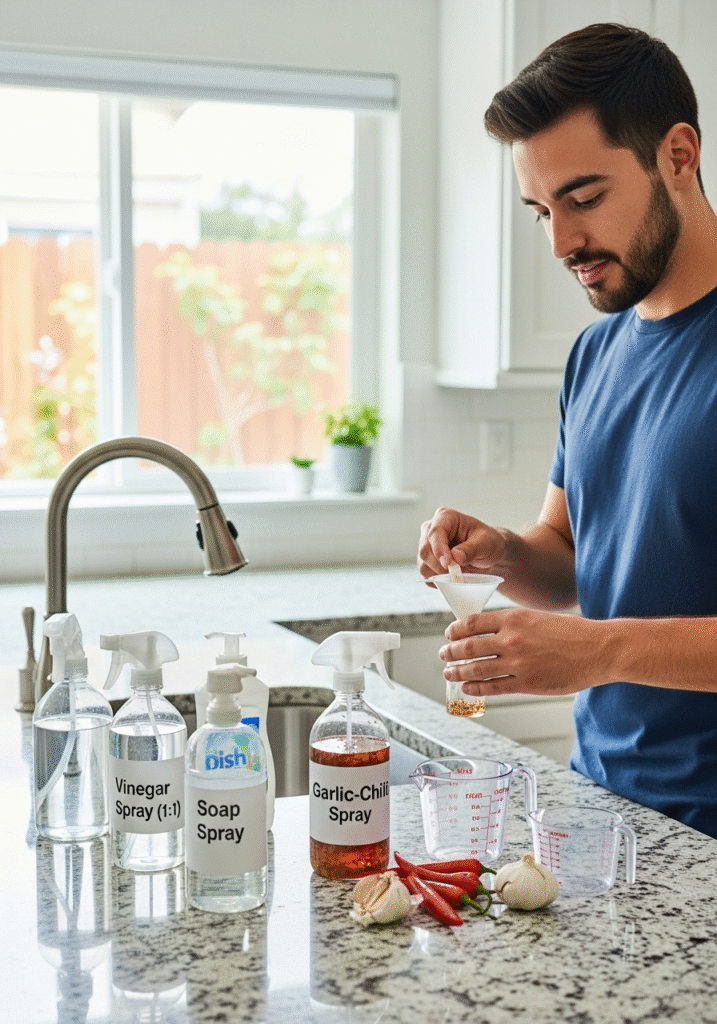
Diatomaceous Earth & Physical Barriers
Natural Pest Control Without Chemicals
When it comes to dealing with insects and pests, sometimes the most effective solutions are the simplest—and safest. Diatomaceous earth and physical barriers offer a powerful, natural alternative to toxic sprays and chemical treatments. These methods work by directly targeting how pests enter and survive in your home, without putting your family or pets at risk.
Diatomaceous Earth: A Natural Insect Killer
Food-grade diatomaceous earth is a fine, white powder made from fossilized aquatic organisms known as diatoms. Though it feels soft to the touch for humans and animals, it’s deadly to insects. Its microscopic particles have sharp edges that scratch and dehydrate the waxy coating on bugs’ exoskeletons, causing them to dry out and die. It’s especially effective against ants, cockroaches, silverfish, fleas, and bed bugs.
To use it safely:
- Sprinkle a light layer around baseboards, window sills, under sinks, and near any known entry points.
- Avoid applying in areas where wind or fans can blow the powder around.
- Reapply after vacuuming or cleaning for continuous protection.
Make sure you use only food-grade diatomaceous earth, as the industrial kind (used in pool filters) is not safe for indoor use.
Physical Barriers: Blocking Entry Before It Starts
While diatomaceous earth kills bugs after they’ve entered, physical barriers work to keep them out entirely. One of the most effective ways to prevent infestations is by installing fine mesh screens on all windows, doors, air vents, and other openings where insects might squeeze through. These screens create a physical shield without impacting airflow or visibility.
Other barrier ideas include:
- Using door sweeps and sealing gaps around pipes or cables.
- Placing weather stripping along windows and doors to close off small crevices.
- Applying caulk to cracks in walls or around baseboards.
Combined, these two strategies form a powerful defense system that doesn’t rely on synthetic chemicals. They’re perfect for households that prefer eco-friendly solutions or have sensitive members, such as young children or pets.

Companion & Repellent Plants
Not all pest control needs to come in the form of sprays, traps, or chemicals. Sometimes, the most effective (and beautiful) solution comes from nature itself. Companion and repellent plants are a smart, eco-friendly way to reduce pest problems while also enhancing your home’s look and air quality. These plants naturally emit scents and oils that certain insects can’t tolerate, helping to keep bugs like mosquitoes, roaches, aphids, and fleas far away from your living space.
Let’s explore how these botanical allies can help you create a green, pest-resistant environment around your home—inside and out.
Basil, Mint, and Lavender: Aromatic Herbs That Keep Bugs at Bay
These common herbs do more than flavor your cooking—they serve as natural insect deterrents when planted strategically.
- Basil is especially effective against mosquitoes and houseflies. It produces a strong aroma that repels insects, making it an excellent choice for window sills, kitchen gardens, or outdoor sitting areas.
- Mint (especially peppermint and spearmint) drives away ants, spiders, and mosquitoes. Be cautious when planting mint in garden beds—it spreads quickly and is best kept in pots.
- Lavender is well-known for its calming scent, but it’s also a strong mosquito and moth repellent. The essential oils in its leaves and flowers can even deter fleas and ticks.
These herbs can be grown in containers or garden beds and are ideal for placing near doors, patios, or windows to keep flying pests out while beautifying your space.
Marigolds, Chrysanthemums, and Garlic: Functional Flowers and Bulbs
Looking for colorful blooms that also offer pest-fighting power? These plants do double duty.
- Marigolds contain pyrethrum, a natural insecticide that repels whiteflies, aphids, and nematodes. They are ideal for planting around vegetable gardens or borders to protect crops naturally.
- Chrysanthemums, often called “mums,” also contain pyrethrins. These are highly effective against ants, cockroaches, fleas, ticks, and even bed bugs. They’re not only practical—they also brighten up any space with their rich blooms.
- Garlic emits sulfur-based compounds that make it difficult for pests like aphids and beetles to thrive nearby. Crushed garlic can even be used in homemade natural sprays.
These plants are particularly helpful in outdoor gardens, near entrances, and alongside edible plants that tend to attract bugs.
Catnip, Citronella Grass, and Others: Strong Scents, Stronger Protection
If you’re looking for plants that offer wide-ranging pest control, these are top performers.
- Catnip contains nepetalactone, which repels mosquitoes more effectively than some chemical repellents like DEET. Bonus: your cat will love it too!
- Citronella Grass is a tall, fragrant plant used to produce citronella oil, commonly found in mosquito-repelling candles. Unlike the synthetic versions, real citronella grass planted around patios or porches provides continuous protection.
- Lemongrass and rosemary also serve as strong deterrents against flying insects and can be used in cooking, making them doubly useful.
Other useful plants include:
- Bay leaves (to deter pantry pests like weevils)
- Thyme (to keep cabbage worms and whiteflies away)
- Eucalyptus (against flies and mosquitoes)
Tips for Best Results:
- Keep plants healthy—well-watered and exposed to sunlight as needed.
- Crush a few leaves occasionally to release their strongest scent.
- Combine multiple plant types to target a wider range of insects.
- Place near doors, windows, patios, and kitchens for strategic coverage.
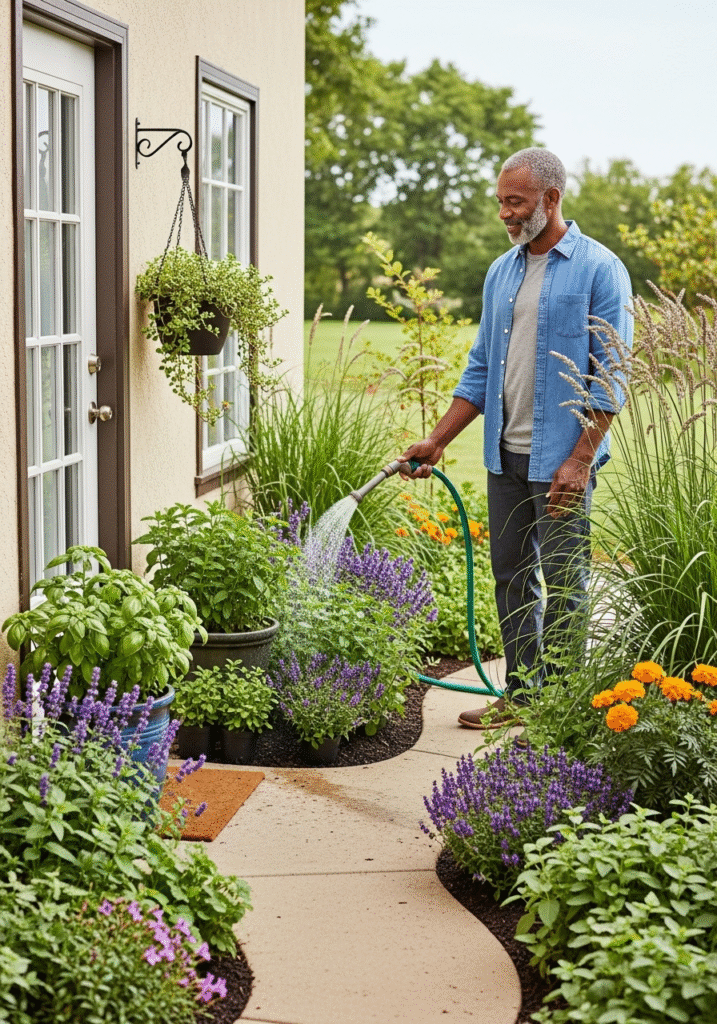
Fresh-Smelling Fabrics: Sheets, Curtains, and Sofas
How to Keep Home Fabrics Smelling Clean, Naturally
Fabrics are cozy and comforting, but they’re also magnets for odors. Whether it’s from cooking, pets, smoke, or daily living, textiles like curtains, sofa cushions, bed linens, and throw blankets can absorb smells faster than you think. Over time, this can leave your home smelling stale—even if it looks clean on the surface.
Luckily, with a few easy maintenance habits and some natural cleaning tricks, you can keep all your home fabrics smelling fresh and inviting every day. Here’s how to banish bad odors and refresh your space without harsh chemicals.
Wash Curtains, Covers, and Linens Regularly
While we often remember to wash clothes and bed sheets, items like curtains, cushion covers, and decorative throws are easy to forget. But these absorb airborne particles and odors just as easily—if not more.
- Curtains should be washed at least once a month, especially in kitchens, living rooms, or homes with pets.
- Cushion covers, throws, and slipcovers benefit from monthly laundering as well.
- Use a mild detergent with a few drops of essential oil (like lavender or eucalyptus) for a soft, natural scent that lingers gently on the fabric.
Be sure to check care labels for fabric-specific instructions before washing.
Boost Every Load with Vinegar & Essential Oils
To neutralize tough odors like smoke, sweat, or food grease, add ½ cup of white vinegar to your rinse cycle. Don’t worry—the vinegar smell doesn’t linger, and it helps kill bacteria that cause odors in the first place.
For a fresher finish, add a few drops of essential oil—such as lemon, tea tree, or peppermint—directly into the detergent drawer or onto a wool dryer ball during the drying cycle. This simple step leaves fabrics with a subtle, pleasant scent that feels naturally clean.
DIY Fabric Spray: Freshen Between Washes
Want to give your sofa, curtains, or pillows a quick refresh without doing a full wash? Make your own natural linen spray at home using simple ingredients:
- 1 cup distilled water
- 2 tablespoons witch hazel or rubbing alcohol
- 15–20 drops of essential oil (try lavender for calm, eucalyptus for freshness, or citrus for energy)
Mix and store in a spray bottle. Lightly spritz upholstery, curtains, or even your mattress between washes. This spray helps eliminate light odors and gives your space a spa-like vibe.
Harness the Power of Sunlight
Natural sunlight is one of the oldest and most effective deodorizers. UV rays kill odor-causing bacteria and remove moisture that can lead to mold or mildew.
- Hang pillows, blankets, duvets, and even small rugs in the sun for a few hours.
- Flip items midway to ensure even exposure.
- Let them cool before bringing them back inside.
Not only does this help fabrics smell fresh, but the sunlight also fluffs them up and gives them a refreshed feel without using any machines or products.
Bonus Tip: Prevent Odors Before They Start
- Avoid letting damp towels or blankets pile up.
- Use air purifiers and keep windows open for airflow.
- Store spare linens in breathable cotton bags instead of plastic, which can trap moisture.

Open Windows and Use Cross Ventilation
One of the simplest and most overlooked ways to keep your home fresh and healthy is also one of the oldest—just open the windows. Allowing fresh air to circulate indoors not only clears out unpleasant odors but also reduces indoor pollutants, moisture buildup, and that “stale” feeling that often lingers in closed-up rooms. It’s an easy, energy-free solution that promotes better air quality and boosts overall well-being.
With a few smart habits and the right layout, you can turn your home into a naturally ventilated space that feels breezy, clean, and comfortable all year round.
Open Opposing Windows for Cross Ventilation
To get the best results from natural airflow, aim for cross ventilation. This means opening windows or doors on opposite sides of your home or a room to create a natural pathway for air to move through.
- Open windows for 10–15 minutes daily, preferably in the morning when outdoor air is cooler and cleaner.
- If your home layout allows, open windows on different levels (e.g., downstairs and upstairs) to let warm air escape upward while cooler air flows in.
- Keep interior doors open during this time to help air move freely between rooms.
This method flushes out stale air, odors, dust particles, and even excess humidity—especially useful in kitchens, bathrooms, and bedrooms.
Use Window Fans or Exhaust Fans to Boost Airflow
If natural breezes are limited, add window fans or portable exhaust fans to help draw in or push out air.
- Place one fan facing inward on the cool/shady side of the home and another fan facing outward on the warm/sunny side to actively pull fresh air in and push stale air out.
- Bathroom and kitchen exhaust fans also assist in removing humid, odor-filled air quickly.
This technique is especially helpful on windless days or in rooms that lack opposing windows.
Add Screens and Plants to “Green” the Breeze
While open windows invite fresh air, they can also invite insects. That’s why it’s important to install fine mesh screens on all windows and vents. This way, you can safely ventilate your space without worrying about flies, mosquitoes, or dust.
For an extra layer of freshness, place indoor plants near open windows. Not only do plants add a visual touch of life and comfort, but they also help filter toxins and increase oxygen levels in the air. Favorites like spider plants, peace lilies, snake plants, and pothos are low-maintenance options that thrive in a ventilated environment.
Other Helpful Tips for Natural Ventilation:
- Keep windows clean to allow more light and airflow.
- Use sheer or light curtains during the day to let air in while maintaining privacy.
- Ventilate especially after cooking, cleaning, or showering to eliminate steam and chemical residues.
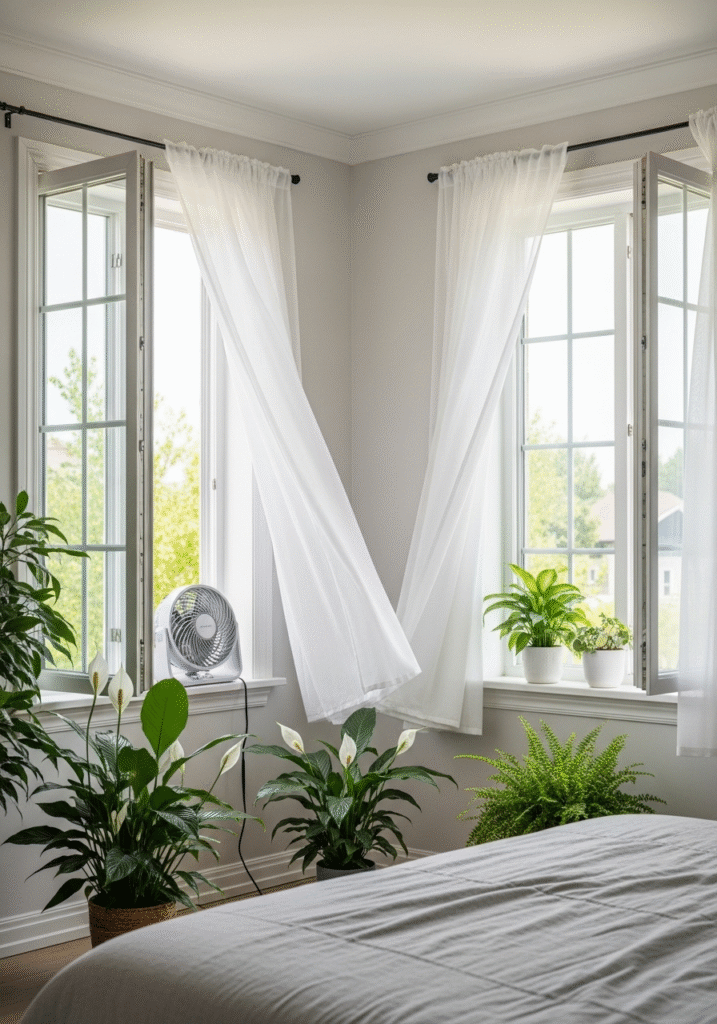
Fridge & Garbage Odor Hacks
anish Stubborn Smells from the Smelliest Spots in Your Home
No matter how clean your kitchen looks, bad smells can quickly take over if they’re coming from your fridge or garbage bin. These two spots are notorious for trapping food residue, moisture, and bacteria—all of which contribute to lingering odors that can be tough to ignore. But the good news? You don’t need expensive products or strong chemical sprays to solve the problem.
With a few smart, natural hacks, you can eliminate fridge and trash odors at the source—and keep your kitchen smelling fresh and inviting every day.
Fridge Odor Hacks: Keep Your Cold Storage Fresh
The fridge is one of the hardest-working appliances in your home, but it’s also a hotspot for hidden odors. Spoiled food, spills, and uncovered leftovers can create musty, sour, or even rotten smells. Here’s how to neutralize them naturally:
- Place Baking Soda or Coffee Grounds Inside
A small, open container of baking soda on a fridge shelf acts like a natural deodorizer, absorbing odors instead of masking them. Replace it every 30 days for best results.
Prefer a richer scent? Try placing dry coffee grounds in a breathable container. They absorb smells and add a warm, earthy aroma to the fridge. - Wipe Shelves with Lemon Juice + Baking Soda
For a deeper clean, mix lemon juice and baking soda into a gentle scrub. The baking soda lifts stains and neutralizes acids, while lemon juice adds a fresh scent and cuts through grease. Use this mixture to wipe down all interior surfaces, including shelves, drawers, and door seals. - Keep a Jar of Activated Charcoal
For long-term odor control, place a small container of activated charcoal in the corner of your fridge. It’s highly absorbent and removes odors on a molecular level—especially helpful for persistent smells like fish, onions, or garlic. Just make sure it’s food-safe and replace it every few weeks.
Garbage Bin Hacks: Stop Odors Before They Spread
The trash can is another source of frequent foul odors, especially in warm weather or when food waste builds up. Here’s how to manage it easily and naturally:
- Sprinkle Baking Soda at the Bottom
Before inserting a new trash bag, sprinkle a generous layer of baking soda at the bottom of the bin. It will absorb liquid, reduce bacteria growth, and keep odors from getting out of hand. - Use Citrus Peels in the Liner
Don’t toss those orange, lemon, or lime peels! Place a few in the bottom of your trash liner. As they sit, they’ll release a pleasant citrus aroma that helps mask unpleasant smells and offers a natural antibacterial boost. - Clean the Bin Weekly with Vinegar + Lemon Water
Once a week (or more often if needed), give your trash bin a proper clean. Mix equal parts white vinegar and warm water, and add a few tablespoons of lemon juice or sliced lemon for freshness. Use this solution to scrub the inside of the bin, rinse thoroughly, and let it air dry. This not only eliminates odor-causing bacteria but also prevents sticky residue and mold from forming.

Pet Smell Solutions—Naturally
Love Your Pet—Not Their Odor: Natural Ways to Keep Your Home Fresh
We adore our pets—they’re family. But even the cutest companions can come with unwanted smells. From wet fur and litter boxes to the occasional “oops” accident, pets can leave behind strong odors that settle into fabrics, carpets, and the air itself. The good news? You don’t have to choose between a fresh-smelling home and your furry friends.
With just a few simple, natural cleaning habits and pet care routines, you can enjoy the love without the lingering scents.
1. Wash Pet Bedding Weekly with Vinegar & Essential Oils
Your pet’s bed is a major source of smells—especially if they spend a lot of time lounging or shedding on it. Oils from their fur, drool, and dander build up quickly.
- Toss pet bedding in the washing machine once a week.
- Use a mild detergent, and add ½ cup of white vinegar to the rinse cycle to help break down odor-causing residues and bacteria.
- For a fresh finish, add 5–10 drops of pet-safe essential oils, like lavender or chamomile. These not only smell good but can help calm anxious pets too.
Make sure the bedding dries completely—damp fabric can trap mildew and undo all your hard work.
2. Neutralize Litter Box Odors with Baking Soda
Cats are clean by nature, but their litter box? Not so much. Even with daily scooping, smells can escape into the air and linger.
- Before adding fresh litter, sprinkle a thin layer of baking soda at the bottom of the box. It helps absorb ammonia-based odors and keeps things fresher longer.
- Avoid using scented litters with strong perfumes—they can bother your cat’s sensitive nose and may lead to litter box avoidance.
For deeper control, empty the box completely every week and scrub it down with vinegar and warm water, then let it air dry before refilling.
3. Clean Pet Accidents Immediately with Natural Enzyme Cleaners
If your pet has an accident—whether on the carpet, rug, or upholstery—speed is key. The faster you clean it, the less likely it is to stain or leave a lingering odor.
- Use a natural enzyme cleaner that breaks down the proteins in urine and waste, neutralizing the smell completely rather than masking it.
- No enzyme cleaner on hand? Mix equal parts vinegar and water, spray the area, blot with a clean cloth, then sprinkle baking soda over the spot to finish. Let it sit, then vacuum once dry.
Never use bleach or ammonia—they can make the smell worse and may attract pets back to the same spot.
4. Brush & Bathe Your Pet Regularly
A clean pet = a fresher home. Regular grooming removes dirt, dander, and the oils that can contribute to odor—especially in dogs with thick coats.
- Brush your pet daily to reduce shedding and remove odor-causing debris.
- Bathe your pet every few weeks, using a pet-safe, natural shampoo. Look for formulas with oatmeal, aloe, or essential oils that are gentle on skin but tough on smells.
Always dry your pet thoroughly, especially behind the ears and under the belly, to prevent that musty “wet dog” scent.
Bonus Tip: Keep the Air Clean Too
- Use HEPA air purifiers to trap pet dander and hair.
- Open windows daily to ventilate the space.
- Wash pet toys and blankets often—they’re sneaky sources of odor!
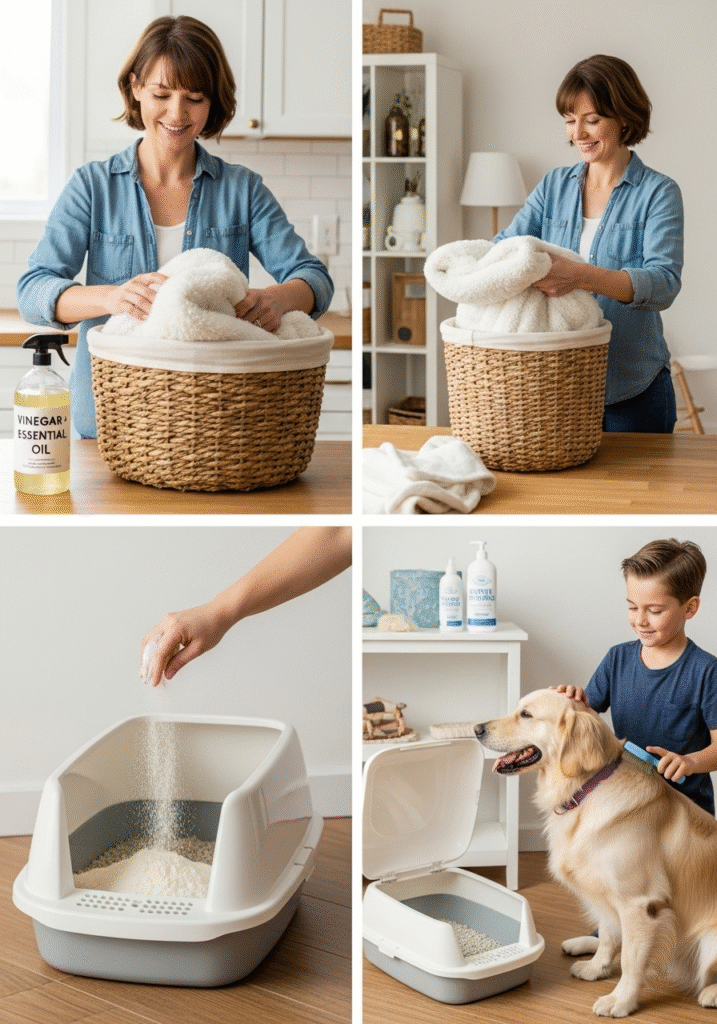
Long-Term Habits for a Continuously Fresh Home
Small Daily Choices That Keep Your Home Smelling Clean and Inviting
A fresh-smelling home isn’t achieved by one big cleaning day—it’s the result of consistent, mindful habits built into your everyday life. While quick fixes like sprays or scented candles offer temporary relief, lasting freshness comes from addressing the root causes of odors: clutter, moisture, stagnant air, and neglect.
By adopting a few simple long-term habits, you can maintain a home that always feels clean, light, and welcoming—without relying on synthetic fragrances or constant deep cleans.
1. Declutter Regularly: Fewer Items = Fewer Odors
Clutter doesn’t just make your home look messy—it gives dust, bacteria, and smells a place to hide. Piles of clothes, extra furniture, or unused items can collect moisture and trap unpleasant odors.
- Make a habit of decluttering room by room, donating or discarding items you don’t use or need.
- Keep surfaces clear and easy to clean.
- Use storage bins with breathable fabric (not plastic) to avoid trapping musty air.
A minimal, organized space allows air to flow freely, reduces dust buildup, and makes cleaning quicker and more effective.
2. Stay On Top of Laundry
Dirty laundry—especially damp towels, gym clothes, and socks—can start to smell fast. Letting it pile up increases the chance of mold or mildew and spreads odors through the house.
- Set a regular laundry schedule (e.g., every 2–3 days).
- Avoid leaving wet or sweaty clothes in baskets—wash them as soon as possible.
- Keep a hamper with ventilation, and clean it occasionally too.
For an extra freshness boost, add vinegar or baking soda to your wash cycle and let clothes dry fully before folding.
3. Keep Shoes Near the Door
Shoes can track in dirt, bacteria, and outside odors—from city streets to muddy gardens. If worn throughout the home, they can spread unwanted smells to carpets, rugs, and flooring.
- Set up a shoe station near the entrance with a mat and a small shoe rack.
- Encourage guests and family members to remove shoes upon entry.
- Occasionally clean or deodorize shoes with baking soda or sunlight exposure.
This simple habit not only protects your floors—it helps reduce odor at the source.
4. Use a Dehumidifier to Control Moisture
Moisture is one of the biggest contributors to musty, stale-smelling homes. It creates the perfect environment for mold, mildew, and bacteria—all of which produce unpleasant odors.
- Invest in a quality dehumidifier, especially if you live in a humid climate or have a basement.
- Aim to keep indoor humidity between 40–50%.
- Check and clean your unit regularly to keep it functioning properly.
In addition, ventilate bathrooms, kitchens, and laundry areas well to remove excess humidity naturally.
5. Make Freshening a Daily Habit
Keeping your home fresh doesn’t require hours of effort—just a few small steps each day can make a big difference over time.
Try incorporating these into your daily or weekly routine:
- Open windows each morning for 10 minutes of fresh air.
- Wipe down kitchen counters and bathroom surfaces with a natural cleaner.
- Toss citrus peels down the garbage disposal or place them in the trash can liner.
- Lightly mist fabrics with a homemade linen spray (water + essential oils + witch hazel).
- Vacuum or sweep high-traffic areas every other day.

